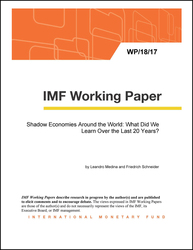
Shadow Economies Around the World: What Did We Learn Over the Last 20 Years?
We undertake an extended discussion of the latest developments about the existing and new estimation methods of the shadow economy. New results on the shadow economy for 158 countries all over the world are presented over 1991 to 2015. Strengths and weaknesses of these methods are assessed and a critical comparison and evaluation of the methods is carried out. The average size of the shadow economy of the 158 countries over 1991 to 2015 is 31.9 percent. The largest ones are Zimbabwe with 60.6 percent, and Bolivia with 62.3 percent of GDP. The lowest ones are Austria with 8.9 percent, and Switzerland with 7.2 percent. The new methods, especially the new macro method, Currency Demand Approach (CDA) and Multiple Indicators Multiple Causes (MIMIC) in a structured hybrid-model based estimation procedure, are promising approaches from an econometric standpoint, alongside some new micro estimates. These estimations come quite close to others used by statistical offices or based on surveys.
Publication date: January 2018
ISBN: 9781484338636
$18.00
Add to Cart by clicking price of the language and format you'd like to purchase
Available Languages and Formats
| English |
Prices in red indicate formats that are not yet available but are forthcoming.
Topics covered in this book
This title contains information about the following subjects.
Click on a subject if you would like to see other titles with the same subjects.
informal economy , survey , multiple indicators multiple Causes (MIMIC) , comparison of different estimation methods , the light intensity approach , predictive mean matching (PMM) , Other , Model Construction and Estimation , Methodology for Collecting , Estimati
Summary
Copyright © 2010 - 2024
Powered by:
AIDC



